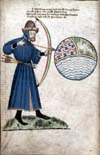| The Attempted Rape |
International
John Gower
Society
|
The
Attempted Rape As Constance drifts back toward Rome from Northumberland in Trevet’s version of the story of Constance, Telous, a renegade Spanish Christian, boards her boat. The scene runs to nearly 450 words:
Gower renders the scene rather differently in some 275 words:
Although the incidents in the two versions of the story of Constance are broadly similar, Gower makes a number of important changes. He gives Constance less agency, makes Maurice younger, makes the would-be rapist more evil, and makes God more powerful. Perhaps Gower’s most obvious alteration is to take agency away from Constance. A small change is that whereas in Trevet, Constance had chosen whether she would sleep on land among heathens or in her lonely boat at sea under the protection of God, in Gower, Constance never goes ashore, never makes a choice about where she sleeps, and never gets to prefer the protection of God to the protection of heathens. Whereas in Trevet Constance had actively rejected Telous’s initial sexual advances, in Gower she never has that opportunity. In Trevet Constance had said that she did not want to make love in the presence of her son and so had promised to satisfy Telous’s desire on dry land, but Gower’s Constance does not mention her son at all. Instead, she meekly asks Theloüs to look out the port to make sure no one will be watching them making love. Gower’s Theloüs is happy enough to seek that assurance, since he had earlier indicated that he wanted to make sure no one else saw the lovely Constance. And, most important, whereas Trevet’s Constance had snuck up behind her abductor and on her own volition pushed him overboard to a watery death, Gower’s Constance merely prays to God, and then God takes the necessary action. Why does Gower deprive Constance of agency, deprive her of virtually all personal independence and strength? One reason is that Gower wants to make Constance a less calculating woman than she was in Trevet by not risking letting readers think of her as a sneaky murderer who would promise one thing to a man and then the next minute push him overboard. Gower prefers to let God do the dirty work. I shall say more about Gower’s depiction of God below. Gower makes another small but important change in the attempted rape scene—this one regarding young Maurice. Whereas Maurice had been a two year-old child in Trevet, Moris is but a one year-old baby in Gower. Gower can scarcely have missed the child’s age in his source, because Trevet’s Constance had made a point of indicating that he was, at two, old enough to be damaged by watching his mother engage in a sex act. She used his age, then, as an excuse for seeking dry land as a place where she and Telous could find a place to make love apart from the probing eyes of Maurice. Gower consciously reduces the age of the child. He specifically has Constance drift near the heathen Spanish castle after she had been at sea but a year: “Whan thilke yer hath mad his ende” (CA, II, 1085). And just before that he mentions that the child is still nursing: “And tho sche tok hire child in honde / And yaf it sowke” (CA, II, 1078-79). Moris’s babyhood is emphasized again when she takes him in her arms, sings, and rocks him to sleep: “Sche wepte, and otherwhile song / To rocke with hire child aslepe” (CA, II, 1080-81). When Theloüs comes into her ship, he finds Constance “with a child upon hire hond” (CA, II, 1096), which I take to indicate the smallness of the baby who is not yet ambulatory, since she still holds him in her hands or arms. Why does Gower make such a change in the age of Moris? One reason is to make the vulnerability of the intended victims even more heartrending. We have endangered here not a mother and young son, but a mother and babe-in-arms. That vulnerability of Constance and Maurice is more pathetic when Gower’s Theloüs threatens to kill Constance if she resists his sexual advances. To kill her would be necessarily to kill as well the infant who is so dependent on her for his very life. Trevet’s Telous had never threatened directly to kill Constance, but had merely offered vague “dures manaces” [“harsh threats”] (NLC, 385) if she resisted. One effect of Gower’s alteration, then, is to make Theloüs even crueler than he had been in Trevet. That cruelty is part of a pattern of changes that Gower makes in the scene. Trevet’s Telous had not been at first such a bad sort. He was a heathen, yes, an apostate who had allowed himself to be carried away from Christ, but it seemed that there was some Christian good left in him. When he first saw Constance, he felt great pity for her and received her graciously. He apparently offered her comfortable lodging, which she refused in preference to the relative safety of her own small boat. That night, in what was apparently a moment of Christian remorse and renewal, he took his treasure down to her boat and asked that he might put himself, through her, into the hands of God and sail with her back to a Christian land. As far as we can tell from Trevet’s text, the noble and good Constance had made still another convert to Christ, and she agreed to let him join her on her journey home. The trouble came not apparently from his own nature, but from a force outside himself identified as “l’enemi” [“the Enemy,” presumably of God] (NLC, 380). This satanic enemy was the guilty party, since through his grievous assault on Telous he tempted him to entice Constance to sin. Telous, then, was as much a victim of the devil’s dire motives as an evil perpetrator himself. Gower makes changes in ways that darken the character of Theloüs. Right from the start Gower tells us that Theloüs “al was badde, / A fals knyht and a renegat” (CA, II, 1092-93). He is not said to feel any pity for Constance, he never offers her food, comfort or lodging ashore, is never inspired by her to seek out once again the roots of his Christian faith, and never asks to join her on a journey to a Christian land. On the contrary, all he can think of when he sees Constance is how pretty she is—“sche was a worthi wiht” (CA, II, 1099). For Theloüs, Constance becomes not the possible avenue of his salvation, but merely the object of his lust. He immediately makes plans to keep other men from seeing her beauty and desiring her also, because he has already made an evil plan to visit her ship at dusk to force his sexual will on her. There is no diabolical intermediary here tempting him to entice her. This man needs no devil to tempt him away from good and toward evil. Rather, he entices her out of his own totally depraved nature, the nature of a man who thinks only of himself with no concern whatever for Constance, her infant son, or the power of God to protect good people from evil influences. That brings up the most important reason why Gower made the renegade more evil: to emphasize the eagerness of God to protect innocence against corruption. God was powerful enough in Trevet’s version. He instructed Constance not to assent to Telous’s evil proposition and he presumably stood with her against “l’enemie.” But in Trevet one suspected that God came in less to help Constance, who never asked for his help, than to do damage to the devil, his old rival. In Gower, where no devil or “enemie” is mentioned, God comes to help Constance as a result of her prayer: “Sche preide god, and he hire herde” (CA, II, 1120). God, not Constance, pushes the diabolical Theloüs overboard. The passage, then, praises not Constance’s cleverness or strength, but God’s attentiveness to prayer and eagerness to protect innocence. The closing summary leaves no doubt: “And thus the myhti goddes hond / Hire hath conveied and defended” (CA, II, 1124-25). There are other changes that Gower makes in the scene of attempted rape, but they are less important than those I have mentioned. For example, whereas Trevet had had Constance’s boat land on the eastern shore of Spain, Gower places the heathen castle on the western shore—her ship is “Estward . . . into Spaigne drive” (CA, II, 1088). The reason for that change is apparently a strictly realistic one, since Gower’s Moris is a year younger than Trevet’s Maurice. Gower apparently thought that Constance’s ship would not have had time to drift all the way around through the Straights of Gibraltar to the eastern side of the Iberian Peninsula. We find other small changes, as well. Gower gives the heathen admiral a far smaller and less kindly role in his tale than the heathen emir had had in Trevet, and he never gives Constance an audience with him in his castle, as Trevet had. Gower does not hint, as Trevet did, that the Christian God might have less power to protect Constance ashore in heathen territory than on the open sea. And Gower makes no mention of the would-be rapist’s bringing his own treasure to the ship—treasure then left in Constance’s possession at the drowning of Telous. Gower makes these changes for obvious reasons: to cut out unnecessary characters and events so that he can focus on more important changes, including the weakness of Constance, who is given almost no important choices in the scene, the pathetic helplessness of the baby Moris, the unparalleled intrinsic evil of Theloüs, and the power of God in immediately answering Constance’s prayers for aid in getting rid of the devil-driven man who would compromise her virtue and endanger her son. Gower’s changes may make Constance, from a modern point of view, a less interesting and less self-reliant person, but they show that he wrote with his own clear vision of the story in mind. The scene is less about Constance than about the mercy of God in protecting the innocent. For Gower, Constance is driven by the wind rather than by her own strength. She is a woman whom God rewards for her passive faith and her prayers rather than for her actions. Originally Posted: April 4, 2006 |
 |
"I throw my darts and shoot my arrows
at the world. But where there is a righteous man, no arrow strikes.
But I wound those who live wickedly. Therefore let him who recognizes
himself there look to himself." Site Hosting Provided Compliments of Western
Carolina University |
 |
